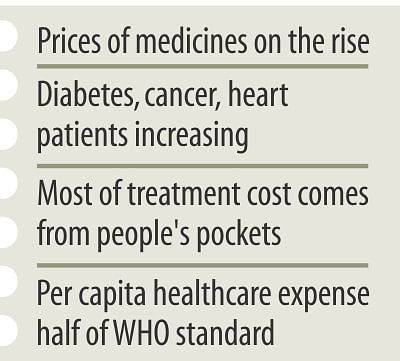Healthcare, drug getting costlier
Healthcare, drug getting costlier
State contributes only 23pc of expenditure

Two-thirds of the country's healthcare expenditures are made for curative purposes while less than one-seventh spent on prevention.
And the lion's share of the medical expenses is spent from people's pockets with the state contributing less than one-fourth, shows a survey.
According to Bangladesh National Health Accounts (BNHA) 1997-2012, expenditure on medicines and curative purposes accounts for 67 percent of the total healthcare expenditure in the country in the 16 years studied.
Spending on medicines and other medical products rose to 41 percent in 2012 from 38 percent in 1997, while the cost of curative services increased to 26 percent from 22 during the same period.
However, spending on preventive cares, including primary healthcare, immunisation, nutrition and public health awareness campaigns, was only 13 percent of the expenditure on healthcare in 2012, according to the report launched at a programme at a city hotel yesterday.
The increase in the expenditure on curative services resulted from a possible rise in the number of people affected by diseases and from the mostly unregulated drug market.
Non-communicable diseases like diabetes, cancer and heart diseases, which require long-term treatment, are on the rise, said Jahangir AM Khan, head of the health economics unit at the International Centre for Diarrhoeal Diseases Research, Bangladesh (icddr,b).
Against this backdrop, the authorities should undertake strategic programmes and set guidelines to encourage people to exercise regularly, reduce smoking and improve food habits, he added.
There is a lack of regulation in drug sales and many buy drugs without any prescription, Jahangir told The Daily Star.
Though non-communicable diseases are increasing, government spending in the health sector has fallen.
In 2012, people spent 63 percent of healthcare expenditure from their pockets against only 23 percent by the government. A little over 8 percent came from development partners while the rest from voluntary healthcare schemes like health insurances and employers, said Ashadul Islam, director general of the Health Economics Unit (HEU) of the health ministry, while presenting the survey report.
The HEU conducted the study with support from the World Bank, Rockefeller Foundation, World Health Organisation and German development agency GIZ.
The per capita spending on health was equivalent to $27 in 2012, which is well below the $54, the minimum per-head healthcare expenditure recommended by the World Health Organisation.
Total healthcare expenditure in 2012 was Tk 325.1 billion, up from Tk 153.9 billion in 2007. However, 3.54 percent of the gross domestic product (GDP) was spent on healthcare in 2012, from 3.63 percent in 2007.
In 2012, Dhaka division had the highest per capita spending of Tk 2,722 crore on healthcare, followed by Khulna (Tk 2,371 crore) and Chittagong (Tk 1,930 crore). The lowest per capita spending was in Sylhet division -- Tk 1,379 crore.
Ravi Rannan-Eliya, an international health expert, said the present healthcare spending was not consistent with the goal of achieving the Universal Health Coverage (UHC) by 2032.
The countries that have already achieved the UHC spend more on healthcare, he said at the programme.
As development partners are funding less, the money should come from taxation, Ravi added.
State Minister for Health Zahid Maleque said though public spending on healthcare was not impressive, Bangladesh saw great achievements in the sector, like a drop in child and maternal mortality rates and an increase in life expectancy.
The country is facing environmental issues like water and air pollutions that have impacts on public health, he said.
Maleque stressed the need for improving healthcare services, and pledged to introduce social health insurance schemes soon.